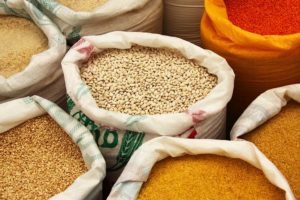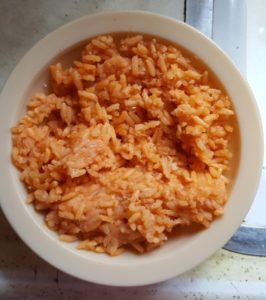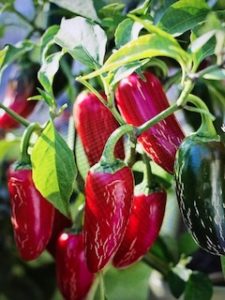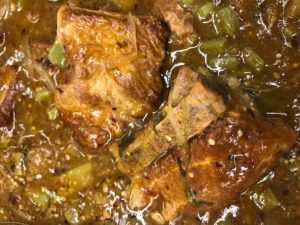Costillitas is a Mexican dish served with refried beans and Mexican rice. Traditionally these pork ribs are slathered with barbecue sauce and smoked, baked or barbecued over a grill. Many people have a wide variety of ways to cook the ribs. Some people will boil or even broil before beginning their traditional recipe. Over the years, there have been countless events where entries are submitted to be nominated for best ribs ever.

Costillitas en Chile Verde brings me back wonderful memories, memories that evoke my taste buds to water. They bring me a feeling of warmth, a feeling of being home again. When I was young my family would gather around the kitchen while the radio was playing and cook together. My aunts tell us stories about their childhood in our hometown of Aguascalientes, which means hot waters. They got this name because of the number of hot springs in the area. Aguascalientes is also known for their lavish fiestas, which come once a year. One of the biggest is La Feria de San Marcos, which lasts from April 15th through May 15th every year.
Hundreds of families travel back to join their loved ones in the celebration. During this celebration, people can attend different events, from concerts to rodeos and even cockfights if you are into those types of entertainment. My family’s favorite part would be the spectacular array of dishes to pick from. During this time mothers and grandmothers take advantage and splurge on their families’ favorites. It is a time to show off if you will. Many people take advantage to visit longtime friends and reconnect with the past. So during this time, people will be invited to many meals or a warm cup of coffee with a pastry, for example, sweet bread or champurrado which is a warm drink made of cinnamon, chocolate, flower, and piloncillo. This is not exactly my favorite, but most of my family loves it.
The dish my grandmother loves to have ready for us would be her famous “Costillitas en Chile Verde.” My grandmother has spent her life making sure we have great memories to learn and share with our own families. She has always taught us old traditions about making sure all the women in the family know how to make a great meal. She often explained that it didn’t matter if it was Mexican food, as long as we continued to make a connection through the meals we prepared for the people we cared about.

The Costillitas would begin with a pot that consisted of extremely spicy chili, while the smaller pot would have a children’s version. My favorite part was when a visitor would join and my aunt would have them sample the sauce. Everyone would hold their breath while the person would cringe with burning hot sauce making their ears turn red. Everyone would then laugh while they handed them a packet of sugar to relieve the burning. I don’t know if this is also an old wives’ tale, but it seemed to work.
Costillitas en Chile Verde is a dish served with refried beans and rice during many celebrations. Families often would take advantage offering this dish because it would provide food for a larger crowd. During large celebrations, you might end up with a few pieces of meat and a large spoonful of rice/beans. Rice and beans have always been used as a filler. My grandmother tells of the time when food didn’t always arrive at the table the way it does here. She explains how back in Aguascalientes she was often forced to give my mom and aunts a single tortilla with salt to put them to bed. Because they farmed crops they never had the luxury to own any cows. She would have to buy milk and cheese. Since she had little to feed them, she would put them to bed early and figured if they were asleep they would feel the hunger a lot less. My aunts explain how they would wake up early with a stomachache of hunger. They often told my grandmother they need to leave early to help one of their great aunts with her chores; but in fact, they would climb the fruit trees to eat all the mangos or whatever was in season.
The lack of resources is why many families have left their beloved homes and traveled to the U.S to find a better life. Leaving the culture and memories has caused a huge impact on most Mexicans in the United States. I would even take the liberty to say that others from different countries have also felt the culture shock. Whether you’re making or tasting traditional dishes, they will always transport you to the most cherished memories. The feeling of being back at home with your loved ones is indescribable. Deserts are also an important part of the tradition. When I was young my grandmother would make Buñuelos, which are fried flour tortillas sprinkled lightly with sugar and cinnamon. Many traditional dishes are recipes passed on for many generations. In some families, certain ingredients are left out so that those dishes will be unique to the person making them. Many families will also never share the recipe if someone was from a different family. All for the sake of bragging rights.
When beginning the process in making Costillitas en Chile Verde you begin with the preparation of the beans. Set a large pot of water with three cups of pinto beans. Pinto beans provide an authentic flavor and are chosen over any other beans. Include two tablespoons of salt and bring to a boil, lower the heat and simmer for about forty-five minutes. Next, begin the process with the rice, two cups rice with a small garlic in a medium pot until golden brown. I enjoy using vegetable oil, but if I remember correctly my grandmother would use lard. Add ¾ of a can of tomato sauce of your choosing and add two tablespoons of salt. For the salt, you can use sea salt as well. Add four cups of water and add half a yellow onion. The yellow onion is much better because it provides a less powerful taste. Bring the pot to a hard boil uncovered. Once the top of the rice is visible and small holes have begun to form, lower the flame and cover for twelve minutes. Try not to open the pot until the rice is done the cooking.

 The main course, (Note: A good idea would be to ask the butcher to cut your ribs about two inches wide.) Place a large pot with one tablespoon of vegetable oil and begin simmering the pork ribs. The reason why very little oil is used is because pork many times releases its own oil. This is also the reason we don’t add salt to the ribs themselves because pork can sometimes be very salty. Place ribs in the large pot, and make sure the oil is very hot before the ribs go in. Fry over a high flame until crispy on the outside, which will ensure a tender juicy center. Fry up all the meat quickly so the inside doesn’t dry out. In a different pot add water deep enough to fit in about 25 jalapeños and two large roman tomatoes. I enjoy roman tomatoes better because I notice they are tastier than other tomatoes. Bring them to a boil and after ten minutes place half of the jalapeños and one roman tomato in the blender. You’re welcome to use more roman tomatoes to lessen the spicy taste. Once you have placed them in the blender add one tablespoon of salt and fill halfway with the same water they were boiled in. Next, follow the same instructions for the next batch of jalapeños.
The main course, (Note: A good idea would be to ask the butcher to cut your ribs about two inches wide.) Place a large pot with one tablespoon of vegetable oil and begin simmering the pork ribs. The reason why very little oil is used is because pork many times releases its own oil. This is also the reason we don’t add salt to the ribs themselves because pork can sometimes be very salty. Place ribs in the large pot, and make sure the oil is very hot before the ribs go in. Fry over a high flame until crispy on the outside, which will ensure a tender juicy center. Fry up all the meat quickly so the inside doesn’t dry out. In a different pot add water deep enough to fit in about 25 jalapeños and two large roman tomatoes. I enjoy roman tomatoes better because I notice they are tastier than other tomatoes. Bring them to a boil and after ten minutes place half of the jalapeños and one roman tomato in the blender. You’re welcome to use more roman tomatoes to lessen the spicy taste. Once you have placed them in the blender add one tablespoon of salt and fill halfway with the same water they were boiled in. Next, follow the same instructions for the next batch of jalapeños.

The jalapeños and roman tomatoes should be blended to your liking. Many people like their salsa chunky and for this, you can just pulse the blender a few times. If you like watery salsa, you blend until everything is dissolved. This recipe allows for many changes; for example, you can minimize the number of jalapeños depending on the liking of your family’s spicy tolerance. My grandmother would teach us to choose the jalapeños that had veins running through them because they were spicier. The only thing that should not be changed is the cooking time. A lengthy boiling time is necessary in order to get a soft tender meat. is providing a lengthy boil. This would be the key factor in this dish.
In the same dish where you have the meat, add the sauce and completely cover the meat. Grab a spoon to stir the meat around and try to scrub the small pieces stuck to the bottom of the pot. The sauce should be about two inches higher than the meat; then, bring the pot to hard boil. Once the sauce has begun to boil, cover the pot with a piece of aluminum and place the lid on it. Lower the heat to the lowest level and set the timer for two hours. This will allow enough time for the meat to tenderize.
Preparing the Refried Beans
On a separate flat pan place about two tablespoons of oil and a jalapeno sliced in strips. Once the oil is hot begin placing three serving spoons of beans without juice in the pan carefully!! This will cause the oil to splatter, but it will subside once the beans are all in. Add bean juice until you have reached the consistency of your liking. Bring to a soft boil and begin mashing them slowly. This would be a good time to taste for consistency and the amount of saltiness. Reduce heat to the lowest setting for 10 minutes and once done cover until you are ready to plate all the dishes.
Last but not least, warm up about a dozen of your favorite tortillas. Everyone in my family has a different opinion about the type of tortillas that taste better with this dish. My husband will only eat this dish if there are flour tortillas. My uncles in Mexico will only eat the dish if there are homemade tortillas. I personally love corn tortillas, just the thought of scooping up my beans makes my mouth watery.
Plating
The presentation is everything so try to be neat when placing a spoonful of rice, a spoonful of beans and 2 spoons of Costillitas. Remember to take one of the jalapenos you fried with your beans and finally drizzle some of the same sauce over your plate.
*This dish can also be placed in a slow cooker once all the first steps are completed. Because this is a memorable dish I try not to change too many steps because I feel that the reason why I make it is to enjoy the memories this dish provides. Over time I’m sure my grandmother could have found shortcuts to make the dish easier, but I feel she also followed the recipe for the sake of traditions.
Ingredient needed:
2 ½ lb. of Pork spare ribs (cut into 2-inch strips)
25 jalapenos
3 tomatoes
½ onion
4 tbs. of salt
4 tbs. of pepper
1 lb. of raw beans
2 cup of rice
2 cloves of garlic
1 can of tomato sauce
5 cups of water
Cookware
2 saucepans
1 saucepan lid
1 frying pan
1 blender
1 colander
1 chopping board
2 kitchen spoons
1 knife
Recipe Notes:
Allow all food to cool before storing.
Beans can be made a couple of days in advance and kept in a refrigerator.
Nutritional Information
Serving size: 1plate
1 cup of Costillitas, calories 151, fat 5g, cholesterol 49mg, sodium 45mg, potassium 450 mg, total carbs 4g, sugars 2g, protein 20 g.
1 cup of Rice, calories 199, fat 8.4g, saturated fat 0.7g, polyunsaturated fat 4.8g, monounsaturated fat 4.8g, sodium 487.0mg, potassium 343.0mg.
½ cup of beans, calories 110.5, fat1.5g, sodium 509.6mg, Potassium 419.9mg, carbohydrates 22g, net carbs 13.9g, sugar 1g, fiber 8.1g, protein 6g, Iron 23%.
References:
Beans – Photo by Etty Fidele on Unsplash
“Calories in Homemade Carne De Puerco En Salsa Verde.” Calories in Homemade Carne De Puerco En Salsa Verde – Calories and Nutrition Facts | MyFitnessPal.com, www.myfitnesspal.com/food/calories/homemade-carne-de-puerco-en-salsa-verde-201450660.
“Calories in Mexican Rice – Calorie, Fat, Carb, Fiber, & Protein Info.” SparkPeople, www.sparkpeople.com/calories-in.asp?food=mexican%2Brice.
“Fiestas y Tradiciones En Aguascalientes.” TuriMexico, www.turimexico.com/estados-de-la-republica-mexicana/aguascalientes-mexico/cultura-de-aguascalientes/fiestas-y-tradiciones-en-aguascalientes/.
Martinez, Mely, et al. “Cómo hacer Buñuelos Mexicanos │Deliciosos, un Tutorial fácil!” Recetas de comida mexicana | México en mi Cocina, 22 Jan. 2018, www.mexicoenmicocina.com/como-hacer-bunuelos-mexicanos/.
Much, Inc. Eat This. “Eat This Much, Your Personal Diet Assistant.” Eat This Much, www.eatthismuch.com/food/view/refried-pinto-beans,487782/.
Zimmermann, Kim Ann. “Mexican Culture: Customs & Traditions.” LiveScience, Purch, 19 July 2017, www.livescience.com/38647-mexican-culture.html.
